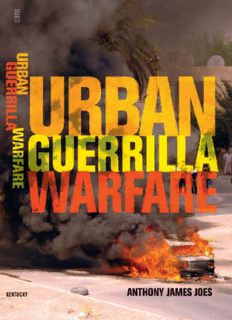
Urban Guerrilla Warfare PDF
Preview Urban Guerrilla Warfare
URBAN GUERRILLA WARFARE This page intentionally left blank URBAN GUERRILLA WARFARE Anthony James Joes THE UNIVERSITY PRESS OF KENTUCKY Publication of this volume was made possible in part by a grant from the National Endowment for the Humanities. Copyright © 2007 by The University Press of Kentucky The University Press of Kentucky Scholarly publisher for the Commonwealth, serving Bellarmine University, Berea College, Centre College of Kentucky, Eastern Kentucky University, The Filson Historical Society, Georgetown College, Kentucky Historical Society, Kentucky State University, Morehead State University, Murray State University, Northern Kentucky University, Transylvania University, University of Kentucky, University of Louisville, and Western Kentucky University. All rights reserved. Editorial and Sales Offices: The University Press of Kentucky 663 South Limestone Street, Lexington, Kentucky 40508-4008 www.kentuckypress.com 11 10 09 08 07 1 2 3 4 5 Library of Congress Cataloging-in-Publication Data Joes, Anthony James. Urban guerrilla warfare / Anthony James Joes. p. cm. Includes bibliographical references and index. ISBN-13: 978-0-8131-2437-7 (hardcover : alk. paper) ISBN-10: 0-8131-2437-9 (hardcover : alk. paper) 1. Guerrilla warfare—History—20th century. I. Title. U240.J584 2007 355.4’25—dc22 2006038457 This book is printed on acid-free recycled paper meeting the requirements of the American National Standard for Permanence in Paper for Printed Library Materials. Manufactured in the United States of America. Member of the Association of American University Presses for Chris This page intentionally left blank Contents Introduction 1 1. Warsaw 1944 9 2. Budapest 1956 39 3. Algiers 1957 53 4. São Paulo 1965 –1971 and Montevideo 1963 –1973 69 5. Saigon 1968 91 6. Northern Ireland 1970 –1998 109 7. Grozny 1994 –1996 131 Conclusion: Looking Back and Ahead 151 Notes 165 Selected Bibliography 201 Index 219 This page intentionally left blank ■ Introduction 1 Introduction More than two millennia ago, Thucydides gave us a description of urban guerrilla warfare, involving Theban troops who were occupy- ing the city of Plataea: The Thebans immediately closed up ranks to repel all attacks on them. Twice or thrice they beat back their assailants. But the Plataean men shouted and charged them, the women and slaves screamed and yelled from the houses and pelted them with stones and tiles; besides, it had been raining hard all night, and so at last their courage gave way and they turned and fled through the city. Most of the Theban fugitives were quite ignorant of the right way out, and this, with the mud and the darkness, and the fact that their pursuers knew their way about and could easily stop their escape, 1 proved fatal to many. This description of classical Hellenic combat will reverberate re- markably through the urban conflicts to be examined in this volume. A World of Cities All across the globe, the human race is crowding into cities. Indeed, “a demographic upheaval of seismic proportions is today transform- ing almost the entire developing world from a predominantly rural 2 society to an urban one.” After the decline of Rome, it required fifteen hundred years for a city to reach a population of one million: that was London. By 1900, perhaps 5 percent of the world’s people lived in cities of over one hundred thousand inhabitants; by 2000,
Description: